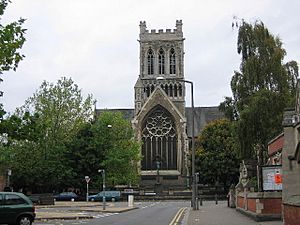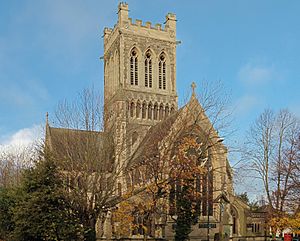St Paul's, Burton upon Trent facts for kids
Quick facts for kids St Paul’s Church, Burton upon Trent |
|
|---|---|

St Paul’s Church, Burton upon Trent
|
|
| Denomination | Church of England |
| Churchmanship | Anglo Catholic |
| Website | St Paul's webpage |
| Administration | |
| Diocese | Diocese of Lichfield |
| Province | Province of Canterbury |
St Paul's Church is a beautiful old church in Burton upon Trent, Staffordshire, England. It's a Church of England parish church, meaning it serves the local community. You can find it on St Paul's Square, close to the Town Hall.
This church first opened its doors in 1874. It was designed by two architects, James M. Teale and Edmund Beckett Denison. Later, more parts were added by another famous architect, G. F. Bodley. St Paul's Church is a very important building, listed as Grade II*, which means it's a special historic place.
The church is part of the diocese of Lichfield. Since 2005, St Paul's has worked closely with St Aidan's, a church in Shobnall. St Paul's also has ties with St John the Divine, Horninglow. The church is usually open most days from 10:30 AM to 4:00 PM. You can also attend services, like the main Sunday Mass at 9:30 AM.
Contents
The Church's Story
The idea for St Paul's Church started in 1865. A small mission, or church outreach, was set up in Borough Road, Burton. This was suggested by a local important person, Michael Thomas Bass. By 1872, this mission was known as St Paul's.
In 1873, the area around it became its own church district. A brand new church, St Paul's, was then built. It opened in 1874 on a spot now called St Paul's Square. Michael Thomas Bass paid for the entire church and its vicarage (the house for the vicar). This cost a lot of money back then! The church was officially blessed on April 7, 1874, by the Bishop of Lichfield, George Augustus Selwyn.
About the Building
St Paul's Church was designed by J. M. Teale and Sir Edmund Beckett Denison. It's built using special stones called Coxbench and Ancaster stone. The church has a cruciform shape, like a cross, when you look at it from above. It has a main area called the nave, a part near the altar called the chancel, and two side sections called transepts.
The church has a tall central tower, which is 123 feet high. Inside the tower are ten bells! The first eight bells were remade in 1912, and two more were added in 1922.
The stone carvings inside the church are very detailed. They show plants, fruits, and animals. The carvings in the nave even represent the twelve months of the year. All the windows have beautiful stone patterns called tracery. Some windows, designed by Archibald John Davies, are in the Arts and Crafts style. These were added between 1919 and 1934.
Between 1889 and 1901, parts of the church were changed by George Frederick Bodley. This was paid for by Michael Bass, 1st Baron Burton. For example, a side chapel was created for daily services. A special room for church items, called a sacristy, was also added.
The ceiling of the chancel was painted, and a fancy cover was put over the stone pulpit. The church also got new organ cases, designed by Bodley. The floor of the chancel was relaid with red and white marble. A new reredos, a decorated screen behind the altar, was put in. It showed the Crucifixion surrounded by saints.
Many other changes happened in the 20th century, mostly paid for by people who attended the church. A new entrance area, called a narthex, was added in 1910. This was a memorial to Baron Burton. A war memorial was put in the churchyard in 1920. In 1931, a stone bishop's chair was built into the sanctuary wall.
In 1979, two parts of the nave and the narthex were turned into a church hall. At this time, several items from another church, St Margaret's, were moved to St Paul's. These included a wooden lectern, a painting of the Crucifixion, and statues.
A writer named Arthur Mee once said about St Paul's: "All is nobly rich and beautiful in this wonderful church." In 1950, the church became a Grade II* listed building, recognizing its special historical and architectural importance.
The Organ at St Paul's
The church has a history of impressive organs. In 1894-1895, the original organ was replaced by a new one. This was the first organ built entirely by the Hope-Jones Electric Organ Company Ltd.
However, this Hope-Jones organ was replaced again in 1985. Parts of it, including the console (where the organist plays), were moved to a special center for theatre organs. The older Hill organ, which was moved out in 1896, eventually found a new home in a church in Berlin, Germany, in 2012.
Today, St Paul's Church has an organ that used to be in a church in Chesterfield. You can find it in the north chancel aisle. The large organ case in the south transept is now empty, except for a few big pipes from earlier instruments.
Organists of St Paul's
Many talented musicians have played the organ at St Paul's Church:
- Dr Arthur Blurton Plant, 1874–1914. He was the organist for 40 years and only missed one Sunday!
- Arthur William Keith Plant, 1914–1940 (son of A. B. Plant)
- Dennis Townhill, 1942–1943
- Walter Cox, 1945–1968
- Terence W. Bennett, 1977–1984
Vicars of St Paul's
The vicar is the priest in charge of the church. Here are some of the vicars who have served St Paul's Church:
- James Henry Fish, 1874–1887
- Frederic Hicks Beaven, 1887–1901 (later became a Bishop)
- Joseph John Gabbett Stockley, 1901–1919 (later became a Canon of Lichfield Cathedral)
- Sydney George William Maitland, 1919–1927
- John Goodacre, 1927–1933
- Basil Henry Winterbotham, 1933–1944
- W. Willis Price, 1944–1959
- W. B. Woolley, 1958–1974
- Rev Ronald N. Whittingham, 1975–1980
- David Morris, 1981–1999
- Paul Andrew Farthing, 2005–2013
- William Stanley Monkhouse, 2014–2019 (also Vicar of St Modwen's Church)


